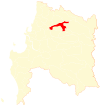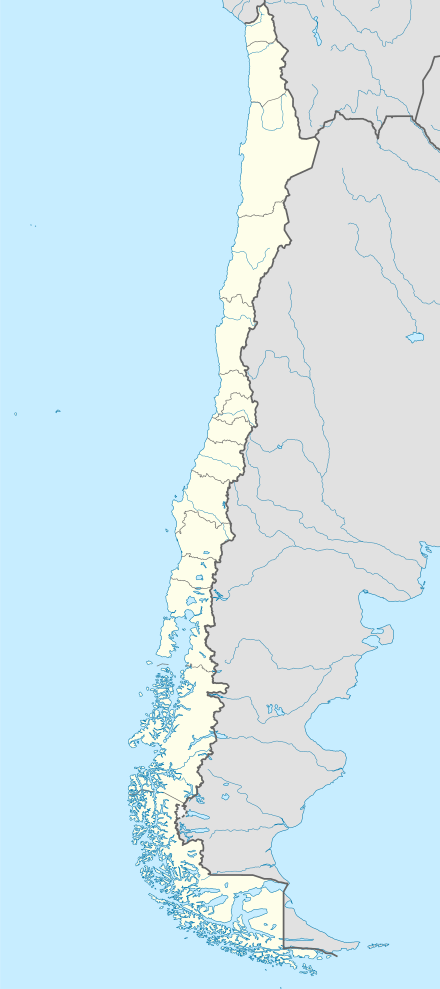Chillán
| Chillán [1] | |||||
|---|---|---|---|---|---|
| City and Commune | |||||
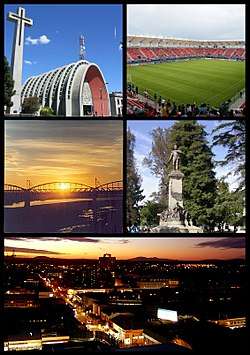 Clockwise, from top: Cathedral of Chillán, Nelson Oyarzún Arenas Stadium, puente ferroviario de Ñuble, Statue of Bernardo O'Higgins, panoramic view of the city at sunset. | |||||
| |||||
| Coordinates: 36°36′S 72°07′W / 36.600°S 72.117°WCoordinates: 36°36′S 72°07′W / 36.600°S 72.117°W | |||||
| Country | Chile | ||||
| Region | Ñuble | ||||
| Province | Diguillín | ||||
| Founded | 1580 | ||||
| Founded by | Martín Ruiz de Gamboa | ||||
| Government[1][2] | |||||
| • Type | Municipality | ||||
| • Alcalde | Sergio Zarzar Andonie (ILE) | ||||
| Area[3] | |||||
| • Total | 511.2 km2 (197.4 sq mi) | ||||
| Elevation | 124 m (407 ft) | ||||
| Population (2012 Census)[3] | |||||
| • Total | 174,777 | ||||
| • Density | 340/km2 (890/sq mi) | ||||
| • Urban | 148,015 | ||||
| • Rural | 13,938 | ||||
| Demonym(s) | Chillanejo or Chillanense | ||||
| Sex[3] | |||||
| • Men | 77,007 | ||||
| • Women | 84,946 | ||||
| Time zone | UTC−4 (CLT) | ||||
| • Summer (DST) | UTC−3 (CLST) | ||||
| Postal code | 3780000 | ||||
| Area code(s) | country + city = 56 + 42[4] | ||||
| Climate | Csb | ||||
| Website | Official website (in Spanish) | ||||
Chillán (Spanish pronunciation: [tʃiˈʎan] or [tʃiˈʝan]) It is the capital city. of the Ñuble Region in the Diguillín Province of Chile located about 400 km (249 mi) south of the country's capital, Santiago,[5] near the geographical center of the country. It is the capital of the new Ñuble Region since 6 September 5. Within the city are a railway station, an inter-city bus terminal, an agricultural extension of the University of Concepción, and a regimental military base. The city includes a modern-style enclosed shopping mall in addition to the multi-block open-air street market where fruits, vegetables, crafts and clothing are sold. The nearby mountains are a popular skiing destination.
History
The zone where Chillán was built was previously inhabited by indigenous people called Chiquillanes.[6]
Chillán was founded in 1580 at the site of Chillán Viejo as San Bartolomé de Chillán by Martín Ruiz de Gamboa[7] , who was campaigning against the local indigenous peoples at the time. However, this moniker did not fare well, and was replaced by the current name, which in the local Indian language means "where the Sun is sitting".
From its foundation, Chillán has been at the heart of Chile's rich agricultural region. It is also in a region of seismic activity, suffering from devastating earthquakes throughout its history; the 1939 Chillán earthquake left over 30,000 dead and mobilized international help.
Chile's national hero, Bernardo O'Higgins, was born in Chillán in 1778. He was the force behind Chile's Independence from Spain, being elected Supreme Director and declaring independence after the Battle of Chacabuco against the Spanish in 1817. His later victory at the Maipo battlefield cemented the country's freedom. He died in exile in Peru in 1842.
Climate
Chillán has a mediterranean climate (Köppen climate classification Csb).[8] Winters are cool but mild with a July average of 7.9 °C (46.2 °F). Most of the precipitation falls during this time of the year with May to July being the wettest months, averaging over 200 millimetres (8 in).[9] Summers on the other hand are dry and warm with a January average of 20.1 °C (68.2 °F) and during this time, precipitation is rare, averaging only 2–3 days per month from December to February. Temperatures can occasionally exceed 30 °C (86.0 °F) anytime from October to April. The average annual precipitation is 1,058 millimetres (42 in) but it is highly variable from year to year with 1982 being the wettest year at 1,813 millimetres (71 in) and 1998 being the driest year at only 473 millimetres (19 in).[9]
| Climate data for Chillan (General Bernardo O'Higgins Airport) 1980–2010, extremes 1952–present | |||||||||||||
|---|---|---|---|---|---|---|---|---|---|---|---|---|---|
| Month | Jan | Feb | Mar | Apr | May | Jun | Jul | Aug | Sep | Oct | Nov | Dec | Year |
| Record high °C (°F) | 41.5 (106.7) |
39.5 (103.1) |
37.8 (100) |
31.8 (89.2) |
27.0 (80.6) |
23.2 (73.8) |
20.4 (68.7) |
25.2 (77.4) |
27.4 (81.3) |
31.4 (88.5) |
33.4 (92.1) |
36.4 (97.5) |
41.5 (106.7) |
| Average high °C (°F) | 29.1 (84.4) |
28.9 (84) |
25.8 (78.4) |
20.3 (68.5) |
15.0 (59) |
12.3 (54.1) |
12.0 (53.6) |
14.1 (57.4) |
16.8 (62.2) |
19.6 (67.3) |
23.1 (73.6) |
26.7 (80.1) |
20.3 (68.5) |
| Daily mean °C (°F) | 20.1 (68.2) |
19.7 (67.5) |
17.4 (63.3) |
13.5 (56.3) |
10.3 (50.5) |
8.6 (47.5) |
7.9 (46.2) |
9.2 (48.6) |
11.0 (51.8) |
13.2 (55.8) |
15.7 (60.3) |
18.4 (65.1) |
13.8 (56.8) |
| Average low °C (°F) | 11.1 (52) |
10.5 (50.9) |
9.0 (48.2) |
6.7 (44.1) |
5.6 (42.1) |
4.8 (40.6) |
3.8 (38.8) |
4.4 (39.9) |
5.1 (41.2) |
6.8 (44.2) |
8.3 (46.9) |
10.2 (50.4) |
7.2 (45) |
| Record low °C (°F) | 1.8 (35.2) |
2.0 (35.6) |
−1.2 (29.8) |
−2.8 (27) |
−5.2 (22.6) |
−6.0 (21.2) |
−7.0 (19.4) |
−4.6 (23.7) |
−3.2 (26.2) |
−2.0 (28.4) |
0.8 (33.4) |
0.0 (32) |
−7.0 (19.4) |
| Average precipitation mm (inches) | 15.2 (0.598) |
22.8 (0.898) |
24.7 (0.972) |
70.8 (2.787) |
202.9 (7.988) |
227.6 (8.961) |
176.1 (6.933) |
123.4 (4.858) |
82.0 (3.228) |
64.8 (2.551) |
31.9 (1.256) |
16.6 (0.654) |
1,058.8 (41.685) |
| Average precipitation days | 2 | 2 | 3 | 7 | 13 | 14 | 14 | 11 | 9 | 7 | 4 | 3 | 89 |
| Average relative humidity (%) | 50 | 53 | 58 | 68 | 80 | 85 | 83 | 78 | 72 | 67 | 60 | 54 | 67 |
| Mean monthly sunshine hours | 359.6 | 296.6 | 260.4 | 177.0 | 120.9 | 87.0 | 105.4 | 142.6 | 183.0 | 229.4 | 282.0 | 334.8 | 2,578.7 |
| Mean daily sunshine hours | 11.6 | 10.5 | 8.4 | 5.9 | 3.9 | 2.9 | 3.4 | 4.6 | 6.1 | 7.4 | 9.4 | 10.8 | 7.1 |
| Source #1: Dirección Meteorológica de Chile[9][10] | |||||||||||||
| Source #2: Universidad de Chile (sunshine hours only)[11] | |||||||||||||
The air in Chillán is the fourth-most polluted in Chile, after Santiago, Temuco, and Concepción. "As in Temuco, the main cause of air pollution in Chillán is the use of wood-burning stoves: about 62% of all households in Chillán use firewood as their main source of heating."[12]
Demographics
According to the 2002 census by the National Statistics Institute, the commune of Chillán spans an area of 511.2 km2 (197 sq mi) and has 161,953 inhabitants (77,007 men and 84,946 women). Of these, 148,015 (91.4%) lived in urban areas and 1,938 (8.6%) in rural areas. The population grew by 8.3% (12,442 persons) between the 1992 and 2002 censuses.[3]
The demonym for a person from Chillán, used for more than 400 years by local residents, is Chillanejo, yet this is not found in the Royal Spanish Academy Dictionary, which only recognizes Chillanense.[13]
Notable people
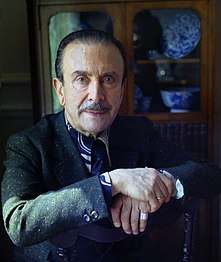
In addition, Chillán has offered a number of great artists to the world. A very notable example is Claudio Arrau, the world-famous pianist. Additionally there is Ramón Vinay, the tenor who was "the" Otello of the 1950s. His recording of the role with Toscanini is a perennial classic. He was a regular at the New York's Metropolitan Opera, where he sang both tenor and baritone roles. One of his last performances at this house was as the Barber of Seville's Basilio, a bass role. He retired from the stage in 1969, in a performance of Otello at Santiago's Municipal Theatre.
Other "chillanejos" are also part of Chile's best artistic and literary traditions: writer Marta Brunet, sculptor Marta Colvin, painter Pacheco Altamirano; and numerous others such as Juan de Dios Aldea who, however, did not reach the international acclaim achieved by Arrau and Vinay. Super Smash Bros. player Gonzalo "ZeRo" Barrios is from Chillán.
Administration
As a commune, Chillán is a third-level administrative division of Chile administered by a municipal council, headed by an alcalde who is directly elected every four years. The 2008-2012 alcalde is Sergio Zarzar Andonie (ILE).[1][2]
Within the electoral divisions of Chile, Chillán is represented in the Chamber of Deputies by Carlos Abel Jarpa (PRSD) and Rosauro Martínez (RN) as part of the 41st electoral district, (together with Coihueco, Pinto, San Ignacio, El Carmen, Pemuco, Yungay and Chillán Viejo). The commune is represented in the Senate by Victor Pérez Varela (UDI) and Felipe Harboe (PPD) as part of the 13th senatorial constituency (Biobío-Coast).
Transport
Nowadays, the city of Chillán is connected to Chile's capital Santiago by both a modern highway and a rebuilt railway system TerraSur that makes the trip in less than five hours. TerraSur, which terminates in Chillán station, and the Alameda-Temuco Train both operate on the railway connecting Chillan with Rancagua and Santiago, although the Alameda-Temuco train also connects Chillan with Temuco.
Gallery
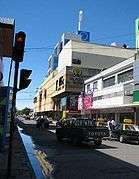
See also
References
- 1 2 3 "Municipality of Chillán" (in Spanish). Retrieved 7 February 2011.
- 1 2 "Asociación Chilena de Municipalidades" (in Spanish). Retrieved 7 February 2011.
- 1 2 3 4 "National Statistics Institute" (in Spanish). Retrieved 9 September 2010.
- ↑ Call prefix for Chillán
- ↑

- ↑ - Chiquillanes, pehuenches y tehuelches, pueblos aborígenes chilenos
- ↑ - El destino infausto de una ciudad
- ↑ Kottek, M.; J. Grieser; C. Beck; B. Rudolf; F. Rubel (2006). "World Map of the Köppen-Geiger climate classification updated" (PDF). Meteorol. Z. 15 (3): 259–263. doi:10.1127/0941-2948/2006/0130. Retrieved December 22, 2012.
- 1 2 3 "Datos Normales y Promedios Históricos" (in Spanish). Dirección General de Aeronáutica Civil. September 2018. Retrieved September 16, 2018.
- ↑ "Temperatura Mensual Histórica de General Bernardo O'Higgins, Chillán Ad. (360011)". Sistema de Administración de Datos Climatológicos (in Spanish). Dirección Meteorológica de Chile. Archived from the original on June 3, 2016. Retrieved May 25, 2016.
- ↑ "Tabla 4.6: Medias mensuales de horas de sol diarias extraídas del WRDC ruso (en (hrs./dia))" (PDF). Elementos Para La Creación de Un Manual de Buenas Prácticas Para Instalaciones Solares Térmicas Domiciliarias (in Spanish). Universidad de Chile. September 2007. p. 81. Retrieved 21 January 2015.
- ↑ Severe air pollution plagues Chilean cities Friday, June 29th 2007 - 21:00 UTC
- ↑ Chillanense - DRAE (Royal Spanish Academy Dictionary)
External links
| Wikimedia Commons has media related to Chillán. |

